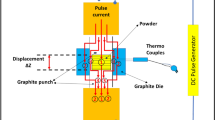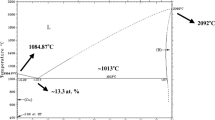Abstract
The present investigation has been revealed that homogeneous silver-tungsten (Ag–W) composite powders doped with cobalt as sinter aid can be produced by the two-stage reduction of co-precipitated tungstate. The sintering of the powders has been studied using dilatometry and the results showed that the critical level for activated sintering is of the order of 0.3 mass percent cobalt with respect to the tungsten content of the compact powder. This critical level is equivalent to approximately six to seven atomic layer coverage of the tungsten particles by cobalt. The levels of cobalt addition above the critical amount leads to the formation of cobalt tungsten (CoW3) intermetallic compound precipitates, which become trapped within the silver phase in the sintered composite material. Microstructural evaluation of sintered specimens has been carried out using optical and electron microscopy. Transmission electron microscopy results revealed the neck formation between adjacent tungsten particles along with the presence of silver around the tungsten particles. Energy dispersive X-ray (EDX) analysis also confirmed that amounts of cobalt was 0.3 mass percent, in the region containing the silver at the tungsten particle interface which agreed with the level of activated sintering.








Similar content being viewed by others
References
Minakova RV, Braterskaya GN, Teodorovich OK. Electrical contact materials: ways of reducing the consumption of tungsten and precious metals—a review. Powder Metall Met Ceram. 1983;22:217–26.
Leung CH, Kim HJ. A comparison of Ag/W, Ag/WC and Ag/MO electrical contacts. IEEE Trans Comp Hybrids Manuf Technol. 1984;CHMT-7(1):69–75.
Witter GJ, Warke WR. Proceedings of the 20th Holm conference on electrical contacts. The use of ceramic matrices infiltrated with silver for electrical contact. Chicago: Illinois Institute of Technology; 1974. p. 78–80.
Wakden P, Sale FR. Silver-tungsten contacts by the hydrogen reduction of silver tungstate. In: Proceedings of the 28th Holm conference on electrical contacts. Chicago: Illinois Institute of Technology; 1982. p. 101–7.
Walkden P, Albisten JN, Sale FR. Reduction of tungstates for production of silver-tungsten and silver-tungsten-nickel electrical contacts. Powder Met. 1985;28:36–42.
Moon IH, Lee JS. Sintering of W-Cu contact materials with Ni and Co dopants. Powder Metall Int. 1977;9:23–4.
Johnson JL, German RM. Chemically activated liquid phase sintering of tungsten-copper. Int J Powder Met. 1994;30:91–102.
Ryu SS, Kim YD, Moon IH. Dilatometric analysis on the sintering behavior of nanocrystalline W-Cu prepared by mechanical alloying. J Alloys Comp. 2002;335:233–40.
Ghosh C, Ozkal B, Upadhyaya A. Effect of activators on sintering of W-Cu alloys. 11th International metallurgy and materials congress. Proceedings E-Book; October 2002. p. 1688–96.
Walkden P, Sale FR. Silver tungsten contacts by the hydrogen reduction of silver tungsten. Proceedings of the annual Holm conference on electrical contacts. 1982. p. 101–7.
Albisten JN, Sale FR. Thermogravimetric studies of the hydrogen reduction of nickel tungstate. Thermochim Acta. 1986;103:175–80.
Sale FR, Albisten JN. Production and sintering of Ag-W composites containing Ni. In: Proceedings of the powder metallurgy-88 conference. Orlando, USA; June 1988. p. 1–15.
Skarsted RM, Geler S. (W4O16)8− polyion in the high temperature modification of silver tungstate. Mat Res Bull. 1975;10:791–9.
Moon IH, Huppmann WJ. Sintering behaviour of tungsten-silver contact materials with cobalt additions. Powder Metall. 1974;6:190–4.
Jones JP, Martin AD. High field microscopy of nickel on tungsten. Surf Sci. 1974;41:559–80.
Aslanoglu Z, Karakas Y, Ovecoglu ML, Ozkal B. Effects of nickel addition on properties of Ag-W electrical contact materials. Powder Metall. 2001;44:77–81.
Gessinger GH, Fischmeisle HF. A modified model for the sintering of tungsten with nickel additions. J Less Common Met. 1972;27:129–41.
Brophy JH, Hayden HW, Wulff J. The final stages of debnsification in nickel-tungsten compacts. Trans Met Soc AIME. 1961;221:1225–31.
Prill AL, Hayden HW, Brophy JH. The role of phase relationship in the activates sintering of tungsten. Trans Met Soc AIME. 1964;230:769–72.
German RM, Ham V. Observations on the compaction of binary thermite powder mixtures. Powder Technol. 1979;22:283–5.
Findik F, Uzun H. Microstructure, hardness and electrical properties of silver-based refractory contact materials. Mater Des. 2003;24:489–92.
Acknowledgements
Financial support from the Higher Education Commission (HEC) Pakistan, Islamabad, Pakistan is gratefully acknowledged
Author information
Authors and Affiliations
Corresponding author
Rights and permissions
About this article
Cite this article
Qureshi, A.H., Azhar, S.M. & Hussain, N. The effect of cobalt addition on sintering and microstructural behaviour of silver–tungsten (Ag–W) composite. J Therm Anal Calorim 99, 203–209 (2010). https://doi.org/10.1007/s10973-009-0152-y
Received:
Accepted:
Published:
Issue Date:
DOI: https://doi.org/10.1007/s10973-009-0152-y




